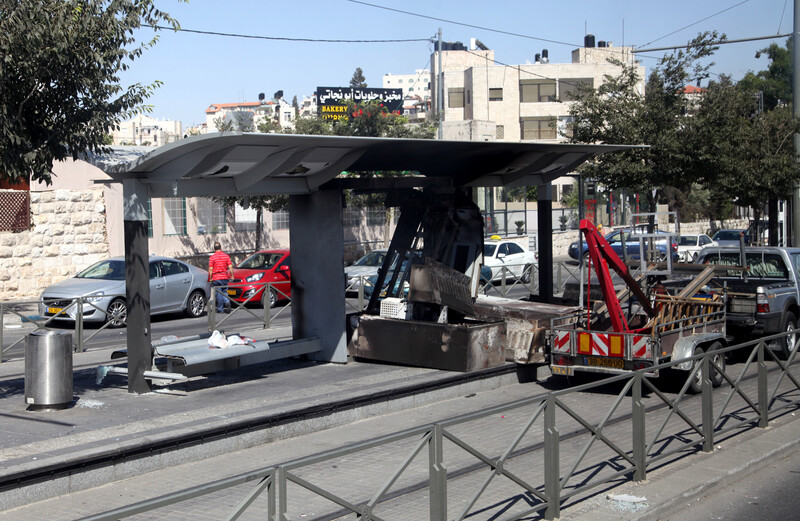Rights and Accountability 30 October 2014

Workers fix the light rail station in Shuafat, Jerusalem. Palestinians destroyed it during protests against the murder of teenager Muhammad Abu Khudair in July 2014.
APA imagesIn July, sixteen-year-old Muhammad Abu Khudair was kidnapped and killed by a group of Israelis who forced petrol down his throat and burnt him alive.
Muhammad lived in Shuafat near a station of the Jerusalem light rail. Palestinian protesters immediately responded to Muhammad’s tragic death with attacks on the light rail because it is hated as a symbol of the Israeli occupation of Jerusalem since it was designed to connect the illegal settlements in the West Bank with West Jerusalem.
It is painful for residents to see settlers pass their neighborhood on the train en route to settlements built on stolen Palestinian land. Meanwhile, Palestinians cannot circulate freely, even within Shuafat.
The light rail line was constructed in the middle of the main road in the neighborhood, leaving only one tight lane for Palestinian traffic. Eight traffic lights along the Shuafat light rail stretch – one every 300 meters — have further slowed down the traffic. The lights are a burden because they are only green for about ten seconds.
It’s unsurprising that the traffic lights were the second target the protesters destroyed, Twitter user @BDS4Justice said in a message to me. “And what a relief. Until now the Israelis did not come and fix the traffic lights and we circulate just fine.” @BDS4Justice, also known as “Zalameh,” is a resident of the Shuafat neighborhood of Jerusalem.
After the destruction of the station and a two-week service disruption, employees of the French multinational Alstom came to fix the tracks. It was not fully repaired, but restored just enough to get the light rail running through the neighborhood for the benefit of Israeli settlers. The destroyed stations in Shuafat were not repaired and remain closed.
Tickets can no longer be purchased at the station, so the light rail is now virtually Arab free, says Zalameh: “No one rides it from here and about one or two alight here coming from West, but it’s really minimal.”
Repression
In 2011, the light rail came to Shuafat with armed guards and surveillance cameras, increasing Israeli control over Palestinian residents. Today, the private armed guards previously stationed there have been replaced by Israeli forces.
Israeli harassment in Shuafat really has “become untenable and a large part [of this] has been due to the light rail,” says Zalameh. There are armed Israeli forces all over Shuafat – every 200 meters about five soldiers. The revolving siren lights from their cars add to the feeling of repression and “being watched.”

A sign at Shuafat light rail station reading: “Please note that tickets for the light rail are temporarily not sold in this station.”
The skyrocketing number of arrests in East Jerusalem reflects this atmosphere of harsh repression. Since July, almost 900 Palestinians have been arrested in Jerusalem, according to Israel’s internal security minister, Yitzhak Aharonovich, speaking to a committee session of the Knesset (Israel’s parliament).
The minister also said he intends to start fining parents of Palestinian youth accused of throwing rocks: “Harming the parents financially will restrain the children.”
Israeli Prime Minister Benjamin Netanyahu is speeding up legislation which will increase punishments for Palestinians throwing rocks — meaning they may face prison terms of up to twenty years.
Under surveillance
The Israeli mayor of Jerusalem, Nir Barkat, visited Shuafat last week along with his police chief. With a huge police force in tow, they gave a press conference next to the light rail. A high-flying balloon with a camera monitored the event. Such new “observation balloons” beam high resolution pictures to the police and are used over occupied Shuafat and Beit Hanina, another Palestinian neighborhood of Jerusalem.
During August and part of September, surveillance was carried out by drones above Shuafat. “We have had helicopters in the skies patrolling low and loudly in the skies across Jerusalem for hours on end,” says Zalameh.
The two French multinationals Veolia and Alstom play a key role in the light rail. The Palestine Liberation Organization objected to the construction of the light rail, since it harms the Palestinian population and its rights to self determination, and took Veolia and Alstom to court in France. The Palestinian BDS National Committee, a coalition of more than 170 Palestinian civil society organizations, also took a public stand against the project.
Despite this clear Palestinian stand against the project, Veolia tried to whitewash the light rail using opinion polls. The company claimed that surveys showed a high level of support for the project in Palestinian neighborhoods of occupied East Jerusalem. However, the veracity of the results could not be assessed since Veolia never provided information about the survey methodology, the questions posed, or the characteristics of those who participated.
Yet the Jerusalem light rail has become a symbol of Israel’s occupation and takeover of Jerusalem. Barkat made this point clear when he told a city council meeting in September that when the light rail operators halt the train of their own accord it would damage “our sovereignty over the city.”
Therefore the boycott, divestment and sanctions movement will continue to target Veolia and Alstom.






Comments
A FORGOTTEN "VICTORY"
Permalink Peter Loeb replied on
I may be mistaken but it seems that not long ago it was said that we (BDS etc)
had a VICTORY and Veolia was the clear loser. At that time, I asked in these
spaces what other investments, profits etc. Veolia had. From my very
simple reading about economics I knew that such details are hardly details
at all in the world of economics.
And here we have Veolia once again playing a key role in the repression
of Palestinians.
While I never claimed any specific knowledge of events-to-come (my own
economic background is that of a neophyte), I am more than familiar with
the complexity of such dealings.
Money attracts money. ("Investments" is a prettier name for it.)
With US/EU backing, Israel is doing just fine. Meanwhile Veolia and Ahlstrom
(two corporations from France) do not object to their anticipated profits. The barbarism of Israel is not really a primary concern in their corporate boardrooms.
---Peter Loeb, Boston, MA USA